Chinatown, San Francisco
| Chinatown | |
|---|---|
| Neighborhood | |
 Chinatown businesses line Jackson Street, with the Bay Bridge in the foreground. | |
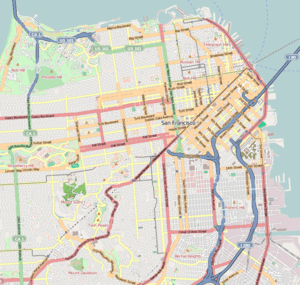 Chinatown Location within Central San Francisco | |
| Coordinates: 37°47′41″N 122°24′26″W / 37.79472°N 122.40722°WCoordinates: 37°47′41″N 122°24′26″W / 37.79472°N 122.40722°W | |
| Country |
|
| State |
|
| City-county |
|
| Government | |
| • Supervisor | Aaron Peskin |
| • Assemblymember | David Chiu (D)[1] |
| • State senator | Scott Wiener (D)[1] |
| • U. S. rep. | Nancy Pelosi (D)[2] |
| Population | |
| • Total | 34,557 |
| Time zone | UTC−8 (Pacific) |
| • Summer (DST) | UTC−7 (PDT) |
| ZIP Codes | 94108, 94133, 94102, 94111, 94109 |
| Area Codes | 415/628 |
The Chinatown centered on Grant Avenue and Stockton Street in San Francisco, California, (Chinese: 唐人街; pinyin: tángrénjiē; Jyutping: tong4 jan4 gaai1) is the oldest Chinatown in North America and the largest Chinese enclave outside Asia. It is the oldest of the four notable Chinatowns in the city.[3][4][5][6][7][8][9] Since its establishment in 1848,[10] it has been highly important and influential in the history and culture of ethnic Chinese immigrants in North America. Chinatown is an enclave that continues to retain its own customs, languages, places of worship, social clubs, and identity. There are two hospitals, numerous parks and squares, a post office, and other infrastructure. While recent immigrants and the elderly choose to live here because of the availability of affordable housing and their familiarity with the culture,[11] the place is also a major tourist attraction, drawing more visitors annually than the Golden Gate Bridge.[12]
Geography and location
 |
Selected locations in Chinatown, San Francisco
1 2 3 4 5 6 7 8 9 10 11 |
Officially, Chinatown is located in downtown San Francisco, covers 24 square blocks,[13] and overlaps five postal ZIP codes (94108, 94133, 94111, 94102, and 94109). It is within an area of roughly a half mile long by a half mile wide with the current boundaries being, approximately, Kearny Street in the east, Broadway in the north, Powell in the west, and Bush Street in the south.[14]
Within Chinatown there are two major north-south thoroughfares. One is Grant Avenue (都板街), with the Dragon Gate ("Chinatown Gate" on some maps) at the intersection of Bush Street and Grant Avenue, designed by landscape architects Melvin Lee and Joseph Yee and architect Clayton Lee; Saint Mary's Square with a statue of Dr. Sun Yat-Sen by Benjamin Bufano;[13] a war memorial to Chinese war veterans; and stores, restaurants and mini-malls that cater mainly to tourists. The other, Stockton Street (市德頓街), is frequented less often by tourists, and it presents an authentic Chinese look and feel reminiscent of Hong Kong, with its produce and fish markets, stores, and restaurants. It is dominated by mixed-use buildings that are three to four stories high, with shops on the ground floor and residential apartments upstairs.[15]
A major focal point in Chinatown is Portsmouth Square.[13] Since it is one of the few open spaces in Chinatown and sits above a large underground parking lot, Portsmouth Square bustles with activity such as T'ai Chi and old men playing Chinese chess.[13] A replica of the Goddess of Democracy used in the Tiananmen Square protest was built in 1999 by Thomas Marsh and stands in the square. It is made of bronze and weighs approximately 600 lb (270 kg).
Demographics
According to the San Francisco Planning Department, Chinatown is "the most densely populated urban area west of Manhattan", with 34,557 residents living in 20 square blocks.[16] In the 1970s, the population density in Chinatown was seven times the San Francisco average.[17]
During the time from 2009 to 2013, the median household income was $20,000 - compared to $76,000 citywide - with 29% of residents below the national poverty threshold. The median age was 50 years, the oldest of any neighborhood.[18] As of 2015, two thirds of the residents lived in one of Chinatown's 105 single room occupancy hotels (SRO), 96 of which had private owners and nine were owned by nonprofits.[19] There are two public housing projects in Chinatown, Ping Yuen and North Ping Yuen.[20]
Most residents are monolingual speakers of Mandarin or Cantonese;[18] in 2015, only 14% of households in the SROs were headed by a person that spoke English fluently.[19] The areas of Stockton and Washington Streets and Jackson and Kearny Streets in Chinatown are almost entirely Chinese or Asian, with blocks ranging from 93% to 100% Asian.[21]
Many of those Chinese immigrants who gain some wealth while living in Chinatown leave it for the Richmond District, the Sunset District or the suburbs.[18]
Demographic history
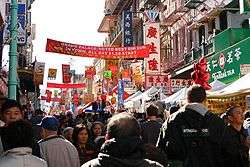
Working-class Hong Kong Chinese immigrants began arriving in large numbers in the 1960s. Despite their status and professional qualifications in Hong Kong, many took low-paying employment in restaurants and garment factories in Chinatown because of limited English. An increase in Cantonese-speaking immigrants from Hong Kong and Mainland China has gradually led to the replacement in Chinatown of the Taishanese dialect by the standard Cantonese dialect.
Due to such overcrowding and poverty, other Chinese areas have been established within the city of San Francisco proper, including one in its Richmond and three more in its Sunset districts, as well as a recently established one in the Visitacion Valley neighborhood. These outer neighborhoods have been settled largely by Chinese from Southeast Asia. There are also many suburban Chinese communities in the San Francisco Bay Area, especially in Silicon Valley, such as Cupertino, Fremont, and Milpitas, where Taiwanese Americans are dominant. Despite these developments, many continue to commute in from these outer neighborhoods and cities to shop in Chinatown, causing gridlock on roads and delays in public transit, especially on weekends. To address this problem, the local public transit agency, Muni, is planning to extend the city's subway network to the neighborhood via the new Central Subway.[22]
Unlike in most Chinatowns in the United States, ethnic Chinese refugees from Vietnam have not established businesses in San Francisco's Chinatown district, due to high property values and rents. Instead, many Chinese-Vietnamese – as opposed to ethnic Vietnamese who tended to congregate in larger numbers in San Jose – have established a separate Vietnamese enclave on Larkin Street in the heavily working-class Tenderloin district of San Francisco, where it is now known as the city's "Little Saigon" and not as a "Chinatown" per se.
History
Origins

San Francisco's Chinatown was the port of entry for early Hoisanese and Zhongshanese Chinese immigrants from the Guangdong province of southern China from the 1850s to the 1900s.[23] The area was the one geographical region deeded by the city government and private property owners which allowed Chinese persons to inherit and inhabit dwellings within the city. The majority of these Chinese shopkeepers, restaurant owners, and hired workers in San Francisco Chinatown were predominantly Hoisanese and male. Many Chinese found jobs working for large companies seeking a source of labor, most famously as part of the Central Pacific[13] on the Transcontinental Railroad. Other early immigrants worked as mine workers or independent prospectors hoping to strike it rich during the 1849 Gold Rush.
Relations between the United States and Qing China were normalized through the Burlingame Treaty of 1868. Among other terms, the treaty promised the right of free immigration and travel within the United States for Chinese; business leaders saw China as a plentiful source of cheap labor, and celebrated the treaty's ratification.[24]
1870s to the 1906 earthquake
Prostitution and ill repute
%2C_Chinatown%2C_San_Francisco_LOC_agc.7a55007_(curves).png)
During the late period of the California Gold Rush, a few Chinese female prostitutes began their sexual businesses in Chinatown. In addition, the major prostitution enterprises had been raised by criminal gang group "Tong", importing unmarried Chinese women to San Francisco.[25] During the 1870s to 1880s, the population of Chinese sex workers in Chinatown grew rapidly to more than 1,800, accounting for 70% of the total Chinese female population.[25]
In the mid-19th century, police harassment reshaped the urban geography and the social life of Chinese prostitutes. Consequently, hundreds of Chinese prostitutes were expelled to side streets and alleys hidden from public traffic.[26] From 1870 to 1874, the California legislature formally criminalized the immigrant Asian women who were transported into California. In 1875, the U.S. Congress followed California's action and passed the Page Law, which was the first major legal restriction to prohibit the immigration of Chinese, Japanese, and Mongolian women into America.[27] In 1882, the Chinese Exclusion Act declared that no more skilled or unskilled immigrants would be allowed to enter the country, which meant that many Chinese and Chinese Americans could not have families in America, because their wives and children were prohibited to immigrate.[28] Simultaneously, the public discourse began to accuse Chinese prostitutes of transmitting venereal diseases. Dr. Hugh Huger Toland, a member of the San Francisco Board of Health, reported that white boys and men contracted diseases when they visited "Chinese houses of prostitution" in Chinatown, in order to warn white citizens to stay away. "When these persons come to me I ask them where they got the disease, and they generally tell me that they have been with Chinawomen."[29]:12–13
The Report of the Special Committee of the Board of Supervisors of San Francisco, on the Condition of the Chinese Quarter of that City (1885)[29]:5
By the end of the 19th century, Chinatown's assumed reputation as a place of vice caused it to become a tourist destination, attracting numerous working class white people, who sought the oriental mystery of Chinese culture, and sought to fulfill their expectations and fantasies about the filth and depravity. The white customers' patronization of Chinatown prostitutes was more extensive than gambling. After catering for three decades to white people as well as Chinese bachelors, Chinatown's prostitution sector developed into a powerful vested interest, favoring the vice industry.[30] As the tourist industry grew up, the visitors came to include members of the white middle class, which pushed the vice businesses to transform into an entertainment industry as a more respectable form in which to serve white customers.
Ah Toy
Ah Toy (c.1828 - 1928) was a Cantonese[31] prostitute and madam in San Francisco during the California Gold Rush, and purportedly the first Chinese prostitute in San Francisco.[32] Arriving from Hong Kong in 1849,[33] she quickly became the most well-known Asian woman in the Old West.[34] She reportedly was a tall, attractive woman with bound feet.[35] When Ah Toy left China for the United States, she originally traveled with her husband, who died during the voyage. Toy became the mistress of the ship's captain, who showered gold upon her, so much so that by the time she arrived in San Francisco in the 1840s,[36] Toy had a fair bit of money. Noticing the looks she drew from the men in her new town, she figured they would pay for a closer look. Her peep shows became quite successful, and she eventually became a high-priced prostitute. In 1850, Toy opened a chain of brothels at 34 and 36 Waverly Place[36] (then called Pike Street), importing girls from China as young as eleven years old to work in them. Her neighbors on Pike Street--conveniently linked to San Francisco's business district by Commercial Street--included the elegant new "parlour house" of madame Belle Cora, and the cottage of Fanny Perrier, mistress of Judge Edward (Ned) McGowan. Towards the end of her life Ah Toy supposedly returned to China a wealthy woman to live the rest of her days in comfort,[37] but came back to California not long afterward. From 1868 until her death in 1928, she lived a quiet life in Santa Clara County, returning to public attention only upon dying three months short of her hundredth birthday in San Jose.[38][39]
.jpg)
Chinese Exclusion
The mostly male Chinese immigrants came to the United States with the intent of sending money home to support their families; coupled with the high cost of repaying their loans for travel, they often had to take any work that was available. Fears began to arise among non-Chinese workers that they could be replaced, and resentment towards Chinese immigrants rose.[40] With extensive nationwide unemployment in the wake of the Panic of 1873, racial tensions in the city boiled over into full blown race riots. The two-day San Francisco riot of 1877 raged through Chinatown in July; four were killed and US$100,000 (equivalent to $2,300,000 in 2017) in property damage was done to Chinese-owned businesses. In response to the violence, the Chinese Consolidated Benevolent Association, also known as the Chinese Six Companies, which evolved out of the labor recruiting organizations for different areas of Guangdong, was created to provide the community with a unified voice. The heads of these companies advocated for the Chinese community to the wider business community as a whole and to the city government.

The state legislature of California passed several measures to restrict the rights of Chinese immigrants, but these were largely superseded by the terms of the Burlingame Treaty of 1868.[40] In 1880, the Burlingame Treaty was renegotiated and the United States ratified the Angell Treaty, which allowed federal restrictions on Chinese immigration and temporarily suspended the immigration of unskilled laborers. Anti-immigrant sentiment became federal law once the United States Government passed the Chinese Exclusion Act of 1882: the first immigration restriction law aimed at a single ethnic group. This law, along with other immigration restriction laws such as the Geary Act, greatly reduced the numbers of Chinese allowed into the country and the city, and in theory limited Chinese immigration to single males only. Exceptions were in fact granted to the wives and minor children of wealthy merchants; immigrants would purchase or partner in businesses to declare themselves merchants in order to bring their families to America. Alternatively, prospective immigrants could become "paper sons" by purchasing the identity of Americans whose citizenship had been established by birthright.[41]:38–39 However, the Exclusion Act was credited with reducing the population of the neighborhood to an all-time low in the 1920s.
.jpg)
Many early Chinese immigrants to San Francisco and beyond were processed at Angel Island, in the San Francisco Bay, which is now a state park. Unlike Ellis Island on the east coast where prospective European immigrants might be held for up to a week, Angel Island typically detained Chinese immigrants for months while they were interrogated closely to validate their papers. The detention facility was renovated in 2005 and 2006 under a federal grant.
Tong wars
As in much of San Francisco, a period of criminality existed during the late 19th century; many tongs arose, trafficking in smuggling, gambling and prostitution. From the mid-1870s, turf battles sprang up over competing criminal enterprises. By the early 1880s, the term Tong war was being popularly used to describe these periods of violence in Chinatown. At their height in the 1880s and 1890s, twenty to thirty tongs ran highly profitable gambling houses, brothels, opium dens, and slave trade enterprises in Chinatown. Overcrowding, segregation, graft, and the lack of governmental control contributed to conditions that sustained the criminal tongs until the early 1920s.
Chinatown's isolation and compact geography intensified the criminal behavior that terrorized the community for decades despite efforts by the Six Companies and police/city officials[42] to stem the tide. The San Francisco Police Department established its so-called Chinatown Squad in the 1880s, consisting of six patrolmen led by a sergeant. However, the Squad was ineffective largely by design. An investigation published in 1901 by the California state legislature found that Mayor James D. Phelan and Police Chief William P. Sullivan, Jr. had knowingly tolerated gambling and prostitution in Chinatown in the interest of bolstering municipal revenue, calling the police department "so apathetic in putting down the horrible system of slavery existing in Chinatown as to justify your committee in believing it criminally negligent."[43] Phelan and Sullivan testified it would take between 180 to 400 policemen to enforce the laws against gambling and prostitution, which was contradicted by the ex-Chief of Police William J. Biggy, who said 30 "earnestly directed" policemen would suffice.[44]:625–630
Bubonic plague
Dr. Williamson, Annual Report to the Board of Health (quoted in 1901)[45]
In March 1900, a Chinese-born man who was a long-time resident of Chinatown was found dead of bubonic plague. The next morning, all of Chinatown was quarantined, with policemen preventing "Asiatics" (people of Asian heritage) from either entering or leaving. The San Francisco Board of Health began looking for more cases of plague and began burning personal property and sanitizing buildings, streets and sewers within Chinatown. Chinese Americans protested and the Chinese Consolidated Benevolent Association threatened lawsuits.
The quarantine was lifted but the burning and fumigating continued. A federal court ruled that public health officials could not close off Chinatown without any proof that Chinese Americans were any more susceptible to plague than Anglo Americans.[46][47][48][49][50]
1906 to the 1960s
The Chinatown neighborhood was completely destroyed in the 1906 earthquake that leveled most of the city.
Relocation and rebuilding
Plans to relocate Chinatown dated back to the years preceding the earthquake. At the 1901 Chinese Exclusion Convention held in San Francisco, A. Sbarboro called Chinatown "synonymous with disease, dirt and unlawful deeds" that "give[s] us nothing but evil habits and noxious stenches".[45] However, as the city rebuilt after the April 1906 earthquake, certain city officials and real-estate developers made more formal plans to move Chinatown to the Hunters Point neighborhood at the southern edge of the city,[51] or even further south to Daly City. Abe Ruef, the political boss widely considered to be the power behind Mayor Eugene Schmitz, invited himself to become part of the Committee of Fifty and formed an additional Subcommittee on Relocating the Chinese, because he felt the land was too valuable for Chinese. Opposition arose, however, from politicians who feared that the removal of the Chinese would affect San Francisco's lucrative trade with Asian countries. Moreover, the government of China was also opposed, and soon after the earthquake, Tsi Chi Chow, the first secretary of the Chinese legation in Washington, DC, arrived in San Francisco, conveying to California governor George Pardee the opposition of China's Empress Dowager Cixi to the plan.[52] The representatives, "acting unofficially", stated "the only way to remove the Chinese from the old Chinatown would be to give them a place elsewhere that would be acceptable for their purpose, when they might be willing to move."[53] The San Francisco Call reported it as "a vigorous protest" and noted that as the site of the Chinese consulate was the property of Imperial China, it could not be reassigned by the city.[54]
Other community leaders pointed out that displaced residents may not stop to resettle in Hunters Point, moving further to other West Coast cities like Seattle or Los Angeles, taking the pool of cheap labor with them.[55] Ironically, plans to relocate Chinatown failed in the end because restrictive housing covenants in other areas of the city prohibited Chinese from settling elsewhere.[56]:92 In November 1907, an article extolling the virtues of the "new Chinatown of San Francisco" was written, praising the new "substantial, modern, fireproof buildings of brick and stone ... following the Oriental style of architecture" and declaring "[n]o more picturesque squalor, no more gambling dens, opium joints or public haunts of vice" would be tolerated, at the command of the Chinese Six Companies. By then, 5,000 residents had returned, of the estimated 30,000 that lived in Chinatown prior to the quake.[57]
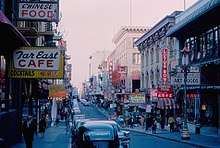
When the earthquake destroyed Chinatown's wooden tenements, it also dealt a death blow to the tongs. Criminal tongs continued on until the 1920s, but after the earthquake legitimate Chinese merchants and a more capable Chinatown Squad under Sgt. Jack Manion gained the upper hand. Manion was appointed leader of the Squad in 1921 and served for two decades. Stiffer legislation against prostitution and drugs ended the tongs.[58] The Chinatown Squad was finally disbanded in August 1955 by Police Chief George Healey, upon the request of the influential Chinese World newspaper, which had editorialized the Squad was an "affront to Americans of Chinese descent".[59]
Nightlife
The famous Sam Wo restaurant opened in 1912.
During the Great Depression, many nightclubs and cocktail bars were started in Chinatown.[60] The Forbidden City nightclub, located at 369 Sutter Street in Chinatown and run by Charlie Low, became one of the most famous entertainment places in San Francisco.[61] While it was doing business, from the late 1930s to the late 1950s, the Forbidden City gained an international reputation with its unique showcase of exotic oriental performance from Chinese American performers.[62] Another popular club for tourists and LGBT clients was Li Po, which, like Forbidden City, combined western entertainment with "Oriental" culture. It was advertised in a 1939 tourism guide book as a "jovial and informal Chinatown cocktail lounge" where one could find "love, passion, and nighttime".[16] As of 2015, it was still in operation at 916 Grant Avenue.[61]
Immigration reform
The Chinese Exclusion Act was repealed during World War II by the Magnuson Act in recognition of the important role of China as an ally in the war. The repeal of the Exclusion Act and other immigration restriction laws, in conjunction with passage of the War Brides Act, allowed Chinese-American veterans to bring their families outside of national quotas and led to a major population boom in the area during the 1950s. However, tight quotas on new immigration from China still applied until the Immigration and Nationality Act of 1965 was passed.
Frank Wong dioramas
San Francisco artist Frank Wong created miniature dioramas that depict Chinatown during the 1930s and 1940s.[63] In 2004, Wong donated seven miniatures of scenes of Chinatown, titled "The Chinatown Miniatures Collection," to the Chinese Historical Society of America (CHSA).[64] The dioramas are on permanent display in CHSA’s Main Gallery.[63][64][65]
1960s–present
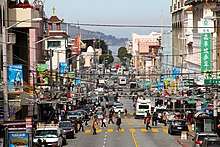
In the 1960s, the shifting of underutilized national immigration quotas brought in another huge wave of immigrants, mostly from Hong Kong. This changed San Francisco Chinatown from predominantly Hlay Yip Wah (Sze Yup or Hoisan Wah)-speaking to Sam Yup Wah (standard Cantonese)-speaking. During the same decade, many stores moved from Grant Avenue to Stockton Street, drawn by lower rents and the better transportation enabled by the 30-Stockton Muni trolleybus line.[66]
.jpg)
There were areas where many Chinese in Northern California living outside of San Francisco Chinatown could maintain small communities or individual businesses. Nonetheless, the historic rights of property owners to deed or sell their property to whomever they pleased was exercised enough to keep the Chinese community from spreading. However, in Shelley v. Kraemer, the Supreme Court had ruled it unconstitutional for property owners to exclude certain groups when deeding their rights. This ruling allowed the enlargement of Chinatown and an increase in the Chinese population of the city. At the same time, the declining white population of the city as a result of White Flight combined to change the demographics of the city. Neighborhoods that were once predominately white, such as Richmond District and Sunset District and in other suburbs across the San Francisco Bay Area became centers of new Chinese immigrant communities. This included new immigrant groups such as Mandarin-speaking immigrants from Taiwan who have tended to settle in suburban Millbrae, Cupertino, Milpitas, and Mountain View – avoiding San Francisco as well as Oakland entirely.
Gang violence
.jpg)
With these changes came a weakening of the Tongs' traditional grip on Chinese life. Newer Chinese groups often came from areas outside of the Tongs' control, so the influence of the Tongs and criminal groups associated with them, such as the Triads, grew weaker in Chinatown and the Chinese community. However, the presence of the Asian gangs remained significant in the immigrant community, and in the summer of 1977, an ongoing rivalry between two street gangs, the Wah Ching and the Joe Boys, erupted in violence and bloodshed, culminating in a shooting spree at the Golden Dragon Restaurant on Washington Street (華盛頓街). Five people were killed and eleven wounded, none of whom were gang members. The incident has become infamously known as the Golden Dragon massacre. Five perpetrators, who were members of the Joe Boys gang, were convicted of murder and assault charges and were sentenced to prison.[67] The Golden Dragon closed in January 2006 because of health violations, and later reopened as the Imperial Palace Restaurant.[68]
Other notorious acts of violence have taken place in Chinatown since 1977. At 2 a.m. on May 14, 1990, San Francisco residents who had just left The Purple Onion, a nightclub located where Chinatown borders on North Beach, were shot as they entered their cars. 35-year-old Michael Bit Chen Wu was killed and six others were injured, among them a critically wounded pregnant woman.[69] In June 1998, shots were fired at Chinese Playground, wounding six teenagers, three of them critically. A 16-year-old boy was arrested for the shooting, which was believed to be gang-related.[70] On February 27, 2006, Allen Leung was shot to death in his business on Jackson Street;[71] Raymond "Shrimp Boy" Chow, who succeeded Leung as head of the Ghee Kung Tong, was later convicted in 2016 of soliciting Leung's murder as fallout from the corruption investigation of Leland Yee,[72] and "Skinny Ray" Lei was indicted for committing the murder in 2017.[73]
Culture
Institutions
San Francisco's Chinatown is home to the Chinese Consolidated Benevolent Association (known as the Chinese Six Companies), which is the umbrella organization for local Chinese family and regional associations in Chinatown. It has spawned lodges in other Chinatowns in the late 19th and early 20th centuries, including Chinatown, Los Angeles and Chinatown, Portland.
The Chinese Culture Center is a community based non-profit organization located on the third floor of the Hilton San Francisco Financial District, across Kearny Street from Portsmouth Square. The Center promotes exhibitions about Chinese life in the United States and organizes tours of the area. The Chinese Historical Society of America is housed in a building designed by Julia Morgan as a YWCA, at 965 Clay.
| No | Name | Year | Address | Notability | Image |
|---|---|---|---|---|---|
| 1 | Dragon Gate | 1970 | Grant at Bush | Southern entrance to Chinatown on Grant. One of the most photographed locations. | 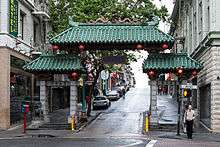 |
| 2 | St Mary's Square | — | 651 California | Features statue of Dr. Sun Yat-sen, by Beniamino Bufano and a memorial for Chinese-American veterans of World Wars I and II. | |
| 3 | Sing Chong building | 1907 | 601–615 Grant | Designed by Ross & Burgren and among the earliest buildings erected after the 1906 earthquake. Strong influence on Chinatown architecture. | .jpg) |
| Sing Fat building | 1907 | 573 Grant | .png) | ||
| 4 | Nam Kue Chinese School | 1925 | 755 Sacramento | Private school offering classes in Chinese culture, history, and language. | |
| 5 | Portsmouth Square | 1800s | 733 Kearny | Oldest public space in San Francisco. | |
| 6 | Chinese Telephone Exchange | 1909 | 743 Washington | All calls to Chinatown were routed by name and occupation until 1948. | .jpg) |
| 7 | Tin How Temple | 1910 | 125 Waverly | Oldest Taoist temple in Chinatown. | .jpg) |
| 8 | Ross Alley | 1849 | Between Jackson, Washington, Grant, and Stockton | Often used as a backdrop for films. | .jpg) |
| Golden Gate Fortune Cookie Company | 1962 | 56 Ross Alley | Working fortune cookie factory and shop. |  | |
| 9 | Chinese Hospital | 1925 (demolished), 1977, 2017 | 845 Jackson | Only Chinese-language hospital in United States. | .jpg) |
| 10 | Chinese Historical Society of America | 1932 | 965 Clay | Former YWCA building designed by Julia Morgan | .jpg) |
| 11 | Six Companies | c.1907 (remodeled 1950s) | 843 Stockton | Sometimes called the "White House" of Chinatown. | .jpg) |

Events
Since the 1950s, a number of Chinese-American leaders organized the San Francisco Chinese New Year Festival and Parade, including art shows, street dances, martial arts, music, and a fashion show. In 1954, the parade added beauty queens to this annual ritual, which by 1958 had been formally expanded into the pageant of "Miss Chinatown U.S.A".[74] In 1994, around 120 queer Asian Americans joined the annual parade, which was the first time that Asian American queer community had appeared in public and gained acceptance from Chinese-American society.[75]
San Francisco Chinatown's annual Autumn Moon Festival celebrates seasonal change and the opportunity to give thanks to a bountiful summer harvest. The Moon Festival is popularly celebrated throughout China and surrounding countries each year, with local bazaars, entertainment, and mooncakes, a pastry filled with sweet bean paste and egg. The festival is held each year during mid-September, and is free to the public.
.jpg)
Chinatown is frequently the venue of traditional Chinese funeral processions, where a marching band (playing Western songs such as Nearer, My God, to Thee) takes the street with a motorcycle escort.[76] The band is followed by a car displaying an image of the deceased (akin to the Chinese custom of parading a scroll with his or her name through the village), and the hearse and the mourners, who then usually travel to Colma south of San Francisco for the actual funeral.[77] By union regulation, the procession route starts at the Green Street Mortuary proceeding on Stockton Street for six blocks and back on Grant Avenue, taking about one hour.[76]
Chinatown Community Development Center
Chinatown Community Development Center is an organization formed in 1977 after the merger of the Chinatown Resource center and the Chinese Community Housing Corporation.[78] The organization was started by Gordon Chin, who served as Executive Director since 1977 until he was succeeded by the organization's Deputy Director Rev. Norman Fong on October 1, 2011. The organization advocates and provides services to San Francisco's Chinatown. They have also started many groups, Adopt-An-Alleyway Youth Empowerment Project being the most notable,[79] and have been involved with many tenant programs.[80]
Media and politics
In the citywide Board of Supervisors elections, Chinatown forms part of District Three and in 2014 accounted for 44% of both registered voters and ballots cast.[18] The two main newspapers read among residents are Sing Tao Daily and World Journal.[18]
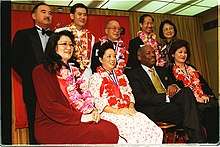
Fame
San Francisco Chinatown restaurants are considered to be the birthplace of Westernized Chinese cuisine such as food items like Chop Suey while introducing and popularizing Dim Sum to Western and American tastes, as its Dim Sum tea houses are a major tourist attraction. Johnny Kan was the proprietor of one of the first modern style Chinese restaurants, which opened in 1953. Many of the district's restaurants have been featured in food television programs on Chinese cuisine such as Martin Yan's Martin Yan - Quick & Easy.
Chinatown has served as a backdrop for several movies, television shows, plays and documentaries including The Maltese Falcon, What's Up, Doc?, Big Trouble in Little China, The Pursuit of Happyness, The Presidio, Flower Drum Song, The Dead Pool, and Godzilla.
Noted Chinese American writers grew up there such as Russell Leong. Contrary to popular belief, while the Chinese-American writer Amy Tan was inspired by Chinatown and its culture for the basis of her book The Joy Luck Club and the subsequent movie, she did not grow up in this area; she was born and grew up in Oakland.[81] Notable 1940s basketball player Willie "Woo Woo" Wong, who excelled in local schools, college and professional teams, was born in, and grew up playing basketball in, Chinatown; a local playground bears his name.[82][83][84] Actor Bruce Lee, who was born at San Francisco Chinese Hospital before moving back to Hong Kong three months later, returned to the United States at the age of eighteen, residing in San Francisco's Chinatown for the first few months before moving to Seattle.
Transportation
San Francisco cable cars have long served areas of Chinatown; the modern system serves the southern and western sections of the neighborhood.
The Stockton Street Tunnel was completed in 1914 and brought San Francisco Municipal Railway Streetcar service to Stockton Street. After the tracks were removed, the overhead wires were maintained and buses replaced streetcars along the route. The 30 Stockton and 45 Union-Stockton are among the most heavily ridden lines in the system. Modern rail service will return at Chinatown station upon completion of the Central Subway.
The Broadway Tunnel was completed in 1952 and was intended to serve as a connection between the Embarcadero Freeway and the Central Freeway. These plans did not materialize due to the highway revolts at the time. The tunnel currently serves to connect Chinatown with Russian Hill and Van Ness Avenue to the west.
In the 1980s, Chinatown merchants were opposed to the removal of the Embarcadero Freeway, but these objections were overturned after it was damaged in the 1989 Loma Prieta earthquake.[85][86] According to the San Francisco Chronicle, activist Rose Pak then "almost single-handedly persuaded the city to build" the $1.5 billion Central Subway project to compensate Chinatown for the demolition of the freeway.[87]
The 49-Mile Scenic Drive is routed through Chinatown, with particular attention paid to the corner of Grant and Clay.
See also
References
- 1 2 "Statewide Database". UC Regents. Retrieved November 21, 2014.
- ↑ "California's 12th Congressional District - Representatives & District Map". Civic Impulse, LLC.
- ↑ Shirley Fong-Torres. Clement Street: The "Other" Chinatown.
- ↑ "City-Data California Ethnic Group Breakdown Page". City-data.com. Retrieved 2011-12-06.
- ↑ Hoiberg, Dale: The New Encyclopædia Britannica MicroPaedia vol. 10, Page 388., Encyclopædia Britannica, Inc, 2007.
- ↑ Wanning, Esther: Culture Shock! USA, Color Plateno. 2, after Page 180., Marshall Cavendish Editions, 2008
- ↑ "USA". Chinatownology.com. Retrieved 2011-10-08.
- ↑ "United Parcel Service Community Site". Community.ups.com. 2008-12-15. Retrieved 2011-12-06.
- ↑ "TED Case Studies/Illegal Immigration Studies Website". .american.edu. Retrieved 2011-12-06.
- ↑ "The Official San Francisco Chinatown Website". Sanfranciscochinatown.com. Retrieved 2011-12-06.
- ↑ Estella Habal. San Francisco's International Hotel: Mobilizing the Filipino American ...
- ↑ "San Francisco Chinatown Page". San Francisco Chronicle. October 27, 2011. Retrieved December 6, 2011.
- 1 2 3 4 5 Lee Foster (1 October 2001). Northern California History Weekends. Globe Pequot. p. 13. ISBN 978-0-7627-1076-8. Retrieved 27 December 2011.
- ↑ Chatfield-Taylor, Joan (1987-04-26). "SHOPPER'S WORLD; SAN FRANSISCO'S VIBRANT CHINATOWN". The New York Times. Retrieved 2018-07-05.
Chinatown, roughly defined as the rectangle formed by Kearny, Powell, Broadway and Bush streets ...
- ↑ Noah Christman; Deland Chan; Vivian Chang; Cindy Wu (April 9, 2012). "Creating a Community Vision for Stockton Street". SPUR.
- ↑ Chinatown Broadway Street Design - Project Overview, San Francisco Planning Department.
- ↑ Estella Habal, San Francisco's International Hotel: Mobilizing the Filipino American Community in the Anti-Eviction Movement 2007. Temple University Press: p. 80.
- 1 2 3 4 5 Green, Emily (2015-11-01). "For Chinatown voters, mayor's support goes only so far". San Francisco Chronicle. Retrieved 2015-11-02.
[Chinatown's] median age is 50, older than in any other neighborhood, according to the city’s Planning Department, which analyzed census data from 2009 to 2013. The median income household income is $20,000, compared with almost $76,000 citywide, the Planning Department found. Twenty-nine percent of residents live below the federal poverty line. Chinese immigrants who make money tend to leave the neighborhood, moving to the Richmond District, the Sunset or the suburbs. ... most Chinatown residents are monolingual Mandarin or Cantonese speakers — even those who have lived in the United States for years ... In 2014, for example, 44 percent of the district’s 33,114 registered voters lived in Chinatown, according to statistics from the city Department of Elections. Chinatown voters also accounted for 44 percent of the total ballots cast in District Three ... The leading Chinese newspapers, Sing Tao Daily and World Journal, have ads for the two [District Three] candidates nearly daily. ...
- 1 2 Kam, Katherine (1 December 2015). "Families Live Jammed into Chinatown Rooms in San Francisco". New America Media. Retrieved 2 December 2015.
- ↑ "Ping Yuen". Chinatown Community Development Center.
- ↑ "Race and Ethnicity in Block Group". Statistical Atlas/U.S. Census Bureau.
- ↑ "Central Subway Overview". Sfmta.com. Retrieved 2011-10-08.
- ↑ Documentary film about the early history of San Francisco's Chinatown, KPIX-TV, 1963.
- ↑ "The Burlingame-Seward Treaty, 1868". Office of the Historian, United States Department of State. Retrieved 6 March 2018.
- 1 2 Tong, Benson (1994). Unsubmissive women: Chinese prostitutes in nineteenth-century San Francisco. Norman: University of Oklahoma Press. ISBN 0806126531.
- ↑ Bérubé, Allan (1990). Coming out under fire: the history of gay men and women in World War Two. New York: Free Press. ISBN 0029031001. Twentieth Anniversary Edition
- ↑ Ling, HuPing (1998). Surviving on the gold mountain: a history of Chinese American women and their lives. Albany: State University of New York Press. ISBN 0791438635.
- ↑ "Becoming American: The Chinese Experience . Charlie Chin Eyewitness | PBS". www.pbs.org. Retrieved 2016-05-05.
- 1 2 Farwell, Willard B. (1885). The Chinese at home and abroad: together with the Report of the Special Committee of the Board of Supervisors of San Francisco on the Condition of the Chinese quarter of that city. San Francisco: A.L. Bancroft & Co. Retrieved 16 June 2018.
- ↑ Light, Ivan (August 1974). "From Vice District to Tourist Attraction: The Moral Career of American Chinatowns, 1880-1940". Pacific Historical Review. 43 (3): 367–394. doi:10.2307/3638262.
- ↑ Stephens, Autumn (1992). Wild Women: Crusaders, Curmudgeons, and Completely Corsetless Ladies in the Otherwise Virtuous Victorian Era. Conari. p. 164. ISBN 0943233364.
- ↑ Asbury, Herbert (2002). The Barbary Coast: An Informal History of the San Francisco Underworld. Thunder's Mouth Press. p. 172. ISBN 1560254084.
- ↑ Espiritu, Yen Le (1997). Asian American Women and Men: Labor, Laws and Love. Rowman & Littlefield. p. 32. ISBN 0803972555.
- ↑ Okihiro, Gary Y. (2001). Common Ground: Reimagining American History. Princeton University Press. p. 99. ISBN 0691070075.
- ↑ Pryor, Alton (2003). Fascinating Women in California History. Stagecoach Publishing. p. 36. ISBN 0966005392.
- 1 2 Bacon, Daniel: Walking the Barbary Coast Trail 2nd ed., pages 52-53, Quicksilver Press, 1997
- ↑ Pryor, Alton (2006). The Bawdy House Girls: A Look at the Brothels of the Old West. Stagecoach Publishing. pp. 36–38. ISBN 0974755176.
- ↑ Yung, Judy (1995). Unbound Feet: A Social History of Chinese Women in San Francisco. University of California Press. p. 34. ISBN 0520088670.
- ↑ Smith, James R. (2005). San Francisco's Lost Landmarks. Quill Driver Books. p. 76. ISBN 1884995446.
- 1 2 "Chinese Immigration and the Chinese Exclusion Acts". Office of the Historian, United States Department of State. Retrieved 6 March 2018.
- ↑ Choy, Philip P. (2012). San Francisco Chinatown: A Guide to Its History & Architecture. San Francisco: City Lights. ISBN 978-0-87286-540-2. Retrieved August 29, 2012.
- ↑ Onion, Rebecca. "A Map of Vice in San Francisco's Chinatown, 1885". Slate Magazine. Retrieved 2 August 2013.
- ↑ "Phelan Must Do His Duty". Los Angeles Herald. 22 February 1901. Retrieved 6 March 2018.
- ↑ Knowland, J.R.; Webber, E.L.; Schillig, Lawrence; Wright, Eli; Laird, J.W.P. (21 February 1901). Report of the Select Committee on Investigation (PDF) (Report). California State Legislature. Retrieved 6 March 2018.
- 1 2 Sbarboro, A. (22 November 1901). "Removal of Chinatown Urged by A. Sbarboro". San Francisco Call. Retrieved 16 March 2018.
- ↑ Kellogg, W.H. (November 1920). "Present Status of Plague, with Historical Review". American Journal of Public Health. Chicago: American Public Health Association. 10 (11): 835–844. doi:10.2105/ajph.10.11.835. PMC 1362904.
- ↑ Lipson, Loren George (August 1, 1972). "Plague in San Francisco in 1900: The United States Marine Hospital Service Commission To Study the Existence of Plague in San Francisco". Annals of Internal Medicine. American College of Physicians. 77 (2): 303–310. doi:10.7326/0003-4819-77-2-303.
- ↑ Risse, Guenter B. (2012). "Bubonic Plague Visits San Francisco's Chinatown". Plague, Fear, and Politics in San Francisco's Chinatown. JHU Press. ISBN 1-4214-0510-5.
- ↑ Chase, Marilyn (2004). The Barbary Plague: The Black Death in Victorian San Francisco. Random House Digital. ISBN 0-375-75708-2.
- ↑ Echenberg, Myron (2007). Plague Ports: The Global Urban Impact of Bubonic Plague: 1894–1901. Sacramento: New York University Press. ISBN 0-8147-2232-6.
- ↑ "Chinatown Never Again to Occupy Former Location". Los Angeles Herald. Associated Press. 24 April 1906. Retrieved 16 March 2018.
- ↑ "Relocation of Chinatown Following the 1906 San Francisco Earthquake". www.sfmuseum.net. Retrieved 2016-12-17.
- ↑ "Chinese seek permanency". Los Angeles Herald. Associated Press. 3 May 1906. Retrieved 16 March 2018.
- ↑ "Chinese Protest Against Forcible Change of Site". San Francisco Call. 3 May 1906. Retrieved 16 March 2018.
- ↑ Gemperlein, Joyce (25 September 1999). "Chinatown Survives S.F. Quake and Racism". Los Angeles Times. Retrieved 16 March 2018.
- ↑ Low, Victor (1982). The Unimpressible Race: A Century of Educational Struggle by the Chinese in San Francisco. San Francisco: East/West Publishing Company, Inc. ISBN 0-934788-03-0. Retrieved 16 March 2018.
- ↑ Carroll, J.M. (1 December 1907). "Stray Things of Interest From San Francisco". Sacramento Union. Retrieved 16 March 2018.
- ↑ Bacon, Daniel: Walking San Francisco on the Barbary Coast Trail; 2nd. ed., pp. 59-62, Quicksilver Press, 1997
- ↑ Davies, Lawerence E. (August 7, 1955). "Coast Chinatown loses tie to past; San Francisco Police Detail, Started in Days of Tong, Passes Tomorrow". The New York Times. Retrieved 2009-10-30.

- ↑ Dong, Arthur E., Lorraine Dong, and Lisa See. 2014. Forbidden City U.S.A. : Chinese American nightclubs, 1936-1970. n.p.: Los Angeles, CA : DeepFocus Productions, c2014
- 1 2 Graves, Donna J. & Shayne E. Watson (2015). "Citywide Historic Context Statement for LGBTQ History in San Francisco" (City and County of San Francisco).
- ↑ Lee, Anthony W. Picturing Chinatown: Art and Orientalism in San Francisco. Berkeley: University of California Press, 2001.
- 1 2 Guthrie, Julian. "Frank Wong recalls life in Chinatown through miniature dioramas". San Francisco Chronicle. Retrieved 26 August 2014.
- 1 2 "Chinatown Miniatures Collection". Chinese Historical Society of America. Retrieved 26 August 2014.
- ↑ ""Chinatown in Miniature" Presentation by Artist Frank Wong". Chinese Historical Society of America. Retrieved 26 August 2014.
- ↑ Nolte, Carl (February 7, 2010). "Shopping for a new year". San Francisco Chronicle.
- ↑ "Inside Chinatown's Gangs". Sfgate.com. 1999-03-09. Archived from the original on August 5, 2011. Retrieved 2011-12-06.
- ↑ Vanessa Hua (2006-10-07). "Golden Dragon Closes and owes a million". Sfgate.com. Retrieved 2011-12-06.
- ↑ Jim Herron Zamora (May 15, 1990). "S.F. Chinatown Shootings May Be Tied to Gang". Los Angeles Times. Retrieved September 16, 2012.
- ↑ Vanessa Hua (June 20, 1998). "Boy, 16, Arrested In S.F. Chinatown Shooting Rampage / Suspect was at scene but didn't fire gun, cops say". San Francisco Chronicle. Retrieved September 16, 2012.
- ↑ Hua, Vanessa (19 March 2006). "Slain Chinatown leader remembered fondly". San Francisco Chronicle. Retrieved 16 March 2018.
- ↑ Egelko, Bob (5 August 2016). "SF crime boss 'Shrimp Boy' Chow gets life, insists he's innocent". San Francisco Chronicle. Retrieved 16 March 2018.
- ↑ Egelko, Bob (27 January 2017). "Las Vegas man charged in notorious 2006 slaying in SF's Chinatown". San Francisco Chronicle. Retrieved 16 March 2018.
- ↑ Yeh, Chiou-Ling (2010). Making an American Festival: Chinese New Year in San Francisco's Chinatown. University of California Press. p. 174. ISBN 9780520253513.
- ↑ Lavilla, S. (1998, Jul 09). A growing show of pride: Record asian american presence at parade reflects a growing acceptance. Asianweek Retrieved from http://search.proquest.com/docview/367563813
- 1 2 Whiting, Sam (2016-09-05). "Around SF's arts scene, the state of the unions is strong". San Francisco Chronicle. Retrieved 2016-09-05.
A Chinatown funeral is done the old way, with a marching band, slow and solemn, marching in three lines for six blocks up Stockton Street and back on Grant, always in the traffic lane with a motorcycle escort. The point of departure is Green Street Mortuary [...] Each funeral procession takes about an hour, often starting with “The Day of Resurrection” and ending with “Nearer, My God, to Thee.”
- ↑ Lucas, Scott (2015-04-23). "Chinatown Decoded: What Happens During a Chinatown Funeral?". San Francisco magazine. Retrieved 2016-09-08.
- ↑ About Archived 2008-09-05 at the Wayback Machine.
- ↑ "HONORING CHINATOWN / A group of young people, most with roots in the historic district, began by scrubbing and sweeping its historic alleys. Now they're giving tours, too". SFGate.com. 2007-05-11. Retrieved 2016-07-22.
- ↑ 10K Group LLC. "Chinatown Community Development Center". Chinatown Community Development Center. Retrieved 2016-07-22.
- ↑ "Amy Tan". Biography.com. Retrieved 2017-12-04.
- ↑ "San Francisco Parks Alliance". Parkscan. Retrieved 2016-07-22.
- ↑ Rivas, Stephen (2008-08-15). "Willie Wong Playground | Stephen Rivas | Flickr". Secure.flickr.com. Retrieved 2016-07-22.
- ↑ "China Visa Office (China Visa Requirements)". Discoverchinatownsf.com. Retrieved 2016-07-22.
- ↑ Wildermuth, John (September 19, 2010). "Chinatown's Champion". SFGate.com. Hearst Newspapers. Retrieved May 28, 2017.
- ↑ King, John (October 17, 2004). "15 SECONDS THAT CHANGED SAN FRANCISCO / The sweeping makeover that transformed the city began 15 years ago today with the Loma Prieta earthquake". San Francisco Chronicle. Retrieved June 8, 2014.
- ↑ "Rose Pak flashes red light on Stockton Street pedestrian mall". San Francisco Chonicle. Retrieved September 19, 2016.
Further reading
- Chinn, Thomas W. Bridging the Pacific: San Francisco Chinatown and its People. Chinese Historical Society of America, 1989.
- Risse, Guenter B. Plague, Fear, and Politics in San Francisco's Chinatown. Baltimore, MD: Johns Hopkins University Press, 2012.
- Tsui, Bonnie. American Chinatown: A People's History of Five Neighborhoods, 2009 ISBN 978-1-4165-5723-4 Official website
- Ki Longfellow, China Blues, Eio Books 2012, ISBN 0-9759255-7-1
- Barbassa, Juliana. "SF Chinatown Still Home to Young and Old." Associated Press at the Washington Post. Friday November 17, 2006.
External links
| Wikivoyage has a travel guide for San Francisco/Chinatown-North Beach. |
| Wikimedia Commons has media related to Chinatown, San Francisco. |
 |
North Beach, San Francisco |
| |||||
| Nob Hill, San Francisco | Financial District, San Francisco | ||||||
| Tenderloin, San Francisco | Union Square, San Francisco | French Quarter, San Francisco |
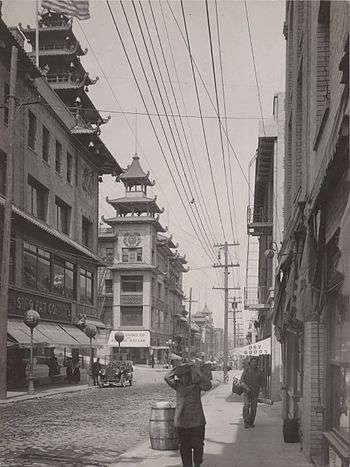
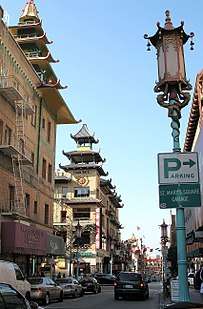
.jpg)
.svg.png)